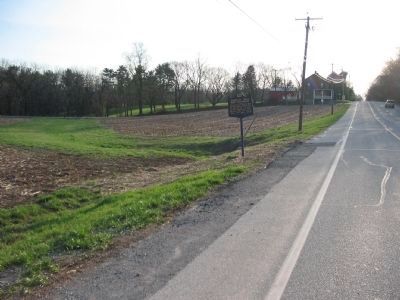Hellam Township near Wrightsville in York County, Pennsylvania — The American Northeast (Mid-Atlantic)
America's First Iron Steamboat
Erected 1947 by Pennsylvania Historical and Museum Commission.
Topics and series. This historical marker is listed in these topic lists: Industry & Commerce • Waterways & Vessels. In addition, it is included in the Pennsylvania Historical and Museum Commission series list. A significant historical date for this entry is November 22, 1825.
Location. 40° 1.292′ N, 76° 32.928′ W. Marker is near Wrightsville, Pennsylvania, in York County. It is in Hellam Township. Marker is at the intersection of Lincoln Highway (Pennsylvania Route 462) and Blessing Road, on the right when traveling east on Lincoln Highway. Touch for map. Marker is at or near this postal address: 6290 Lincoln Hwy, Wrightsville PA 17368, United States of America. Touch for directions.
Other nearby markers. At least 8 other markers are within walking distance of this marker. Wrightsville (approx. 0.3 miles away); Road of Remembrance (approx. half a mile away); World War Memorial (approx. 0.6 miles away); Wrightsville Engagement (approx. 0.6 miles away); Mifflin House (approx. 0.6 miles away); Springetsbury Manor (approx. 0.6 miles away); Veterans Memorial (approx. 0.6 miles away); W. Henry Crumling (approx. 0.7 miles away). Touch for a list and map of all markers in Wrightsville.
Also see . . . The Design of America’s First Iron Steamboat. 2015 article by Stephen H. Smith in the York Daily Record. Excerpt:
In 1825, the majority attitude was, “wood floated and iron sank, why would anybody build a boat out of iron?” However those individuals familiar with the work of Archimedes, knew an iron-hulled boat was possible.(Submitted on October 17, 2020.)
In designing his Iron Steamboat, it is obvious that John Elgar knew about the principle of buoyancy. His formal education consisted of no more than the third grade, however that did not keep him from being self taught; reading any book that he could get his hands on. Likely one of those books presented principles developed by the ancient Greek scientist Archimedes; one of which established that the buoyant force, i.e. upward force, of an object in a fluid is equal to the weight of the fluid displaced by the object.
Credits. This page was last revised on April 9, 2024. It was originally submitted on January 29, 2008, by Bill Pfingsten of Bel Air, Maryland. This page has been viewed 1,483 times since then and 49 times this year. Last updated on April 8, 2024, by Annette Fillmore of York, Pennsylvania. Photos: 1. submitted on January 29, 2008, by Bill Pfingsten of Bel Air, Maryland. 2. submitted on January 15, 2023, by Adam Margolis of Mission Viejo, California. 3. submitted on June 12, 2010, by Craig Swain of Leesburg, Virginia. 4. submitted on January 15, 2023, by Adam Margolis of Mission Viejo, California. • Devry Becker Jones was the editor who published this page.



